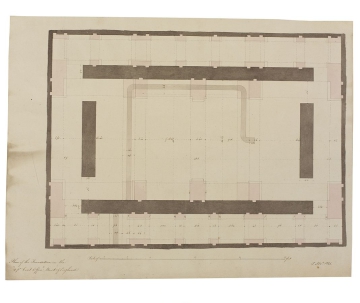
Browse
Reference number
Purpose
Aspect
Scale
Inscribed
Signed and dated
- 15 Novr. 1821.
Hand
Notes
As noted for SM volume 71/44a and SM volume 71/35, inverted foundation arches were an inexpensive method of providing strong foundations where a great weight was to be placed above. The more expensive method involved driving piles deep into the ground and it would have been impractical for Soane to alter the method of construction. Inverted arches counteracted the forces acting on them from above, carrying the strain inwards to the centre, rather than directly down through the pier to the foundation base. The key stone of the inverted arch acts in exactly the same way as a normal arch, taking the pressure.
Additional lengths of stone foundations running from north to south are indicated on the plan, which must have been redundant under Soane's new design - they would have supported Taylor's columns that extended around all four sides of the office. The heating system shown is probably Soane's from an earlier date, because as noted for drawing 7, on 23 May 1790 the Building Commitee (M5/748 Bank of England Committee for Building Minutes Book, 1764-1803) had requested that Soane install two new stoves in the 3 per cent Consols annuities Offices (as the south and south-east Transfer Offices were then called).
Level
Sir John Soane's collection includes some 30,000 architectural, design and topographical drawings which is a very important resource for scholars worldwide. His was the first architect’s collection to attempt to preserve the best in design for the architectural profession in the future, and it did so by assembling as exemplars surviving drawings by great Renaissance masters and by the leading architects in Britain in the 17th and 18th centuries and his near contemporaries such as Sir William Chambers, Robert Adam and George Dance the Younger. These drawings sit side by side with 9,000 drawings in Soane’s own hand or those of the pupils in his office, covering his early work as a student, his time in Italy and the drawings produced in the course of his architectural practice from 1780 until the 1830s.
Browse (via the vertical menu to the left) and search results for Drawings include a mixture of Concise catalogue records – drawn from an outline list of the collection – and fuller records where drawings have been catalogued in more detail (an ongoing process).

